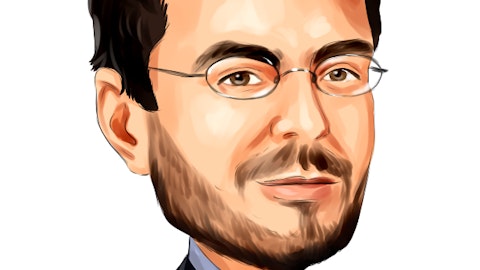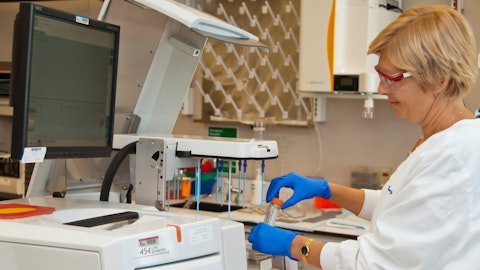Leland Gershell: Hey, good afternoon. Congratulations on progress, and thanks for taking my questions. Also a couple for me on carcinoid, maybe for Alan, with the benefit now of a few months since the reveal from the Phase 2, I want to hear of any feedback you’ve received from physicians with respect to their interest in using Paltusotine in patients who are untreated on SRLs, given the large population segment who is not currently on therapy. And then I have a follow-up.
Scott Struthers: Go ahead, Alan.
Alan Krasner: Well, thanks for the question. We, of course, work closely with a number of specialist physicians, oftentimes oncologists who specialize in neuroendocrine tumor patient care and also themselves usually treat those patients with carcinoid syndrome. A lot of them are our investigators and in our study steering committee, and they — the feedback has been generally very positive from them. They’re very excited about the data we have, and I would say, pleased to be helping us think about what’s coming up in Phase 3, and probably many of them would participate in Phase 3 as well. I think it’s recognized by many of the physicians to treat this, that there are some shortcomings with these injections that are the standard of care for the control of carcinoid syndrome.
And we went through many of those limitations in my prepared remarks, but these are just very burdensome from patients in many ways. They’re also technically difficult to deliver in a reproducible way. And this has actually been shown in the literature in this patient population in particular. So I think both the patients and the physicians have expressed to me, at least, positive thoughts that this would be a real contribution to the field.
Leland Gershell: Thanks. And then further to the point of the data you’ve shown. So the 5HIAA levels and serotonin were pretty well reduced by Paltusotine. It seems like that was much better than we’ve seen with the SRLs. Wondering if that particular finding has resonated with respect to maybe longer-term efficacy beyond, I think, the eight weeks that you’d shown with the Phase 2 for longer-term control of the cardinal symptoms. Thank you.
Alan Krasner: Yes, it’s an interesting question. I’m afraid I don’t know the answer. I’m not sure the answer is even in the literature. The ability of the biomarker responses to sort of predict longer-term responses with respect to these tumors or the symptoms, not really established. These biomarkers are generally used in clinic primarily to diagnose carcinoid syndrome, but their ability to monitor therapy is not well established. But I would — thank you for pointing out that we did see some actually pretty nice responses, and it is hard to find those in the old — older literature. And I suspect that might, in part, have to do with improvements in the methodology for measuring these things. We’re using the latest assays for these biomarkers, and I have a feeling that, that may have contributed to our pretty clear symptom and biomarker responses that we saw. And we, of course, want to leverage this for our Phase 3 program as well.
Scott Struthers: And just to follow up a little. Sorry, this is Scott. Just to follow up a little bit, I did want to note your comment about potentially getting to those patients who currently aren’t treated. And I think that is a unique opportunity. It’s very surprising to me that there is a significant population of patients with carcinoid syndrome that are not being treated at this point when they clearly should be. And I can only explain it by somebody. They must be making some judgment on the burden of treatment versus the burden of disease and/or access to medicines. And it’s causing far too many to not have access to medicines that would help them. So we look forward to trying find ways to bring this to more patients than are currently on the injectable depot therapies.
Leland Gershell: Thanks so much for the added color. Looking forward to hearing more then.
Operator: Your next question comes from Douglas Tsao from H.C. Wainwright. Your line is already open.
Douglas Tsao: Hi. Thanks for — good afternoon. Thanks for taking the questions. I was just curious, maybe, Scott, on the earlier stage pipeline, you have a number of sort of therapeutic areas that you’re targeting, many of which you’re sort of talking about candidate selection for this year. I think you’ve talked about sort of diabetes and obesity for something for next year. I guess, what’s the — or is there any kind of prioritization within those? And how do you think about sort of the pace that those would go into the clinic and start to read out? You guys have a track record for doing sort of innovative early-stage studies that give us pretty good PD data early on in development. And I’m just curious if that’s how you anticipate seeing those for those candidates as well. Thank you.
Scott Struthers: Thanks, Doug. Yes. The emerging pipeline is really super exciting, and we are really committed to what I call the craft of drug discovery. So we want to make sure that these are really the best possible molecules we can make before we invest in development. And so, those programs are now really starting to get close to molecules that might be good enough. PTH is probably first. We’ve been doing some non-GLP tox studies on multiple candidates, and it looks like the team is getting close to selecting the best one out of several good ones. And then the other programs are successively behind that. Fortunately, we’ve been in a financial position where we don’t need to make difficult prioritization decisions about which good molecule to slow down over the other good molecules.
And I do think there’s a little bit of just internal prioritization we have to do as we balance workloads between some of the different projects. But largely, all projects are moving forward as fast as we can. And I’m optimistic that that’s going to leave a whole sequence of upcoming clinical information on these programs over the next 12, 18, 24 months.
Douglas Tsao: Okay, great. That’s really helpful, and congrats on the progress.
Scott Struthers: Thanks.
Operator: Your next question comes from Catherine Novack of Jones Research. Your line is already open.
Catherine Novack: Hi. Oh, hi. Thanks for taking my questions. I just wondering, when it comes to commercialization, what’s the overlap in terms of treatment centers and prescriber base for CAH and acromegaly? And then would there any overlap extend to carcinoid syndrome? Is that a completely different institution that you’re looking at?
Scott Struthers: Thanks, Catherine. It’s a high degree of overlap, and maybe, Jim, you could get into some more detail there.
Jim Hassard: Yes. Thanks, Catherine. In terms of acromegaly and especially carcinoid syndrome, when we look at the 35 to 40 pituitary treatment centers, typically they are academic centers that also overlap with the National Comprehensive Cancer Center Network. So when we’re doing some sales force sizing, we see a lot of overlap between acromegaly and carcinoid syndrome. Even in terms of endocrinologists, there’s a high degree of overlap with acromegaly and Cushing’s disease, of course, because it’s pituitary, but we’re also seeing the same for Congenital Adrenal Hyperplasia. So a lot of the specialist endocrinologists are seeing all three pituitary or adrenal diseases.
Scott Struthers: And I’ll just add that, that was really part of our long-term strategy when we started getting into these indications, so that not only from a commercial point of view do we start building into the same centers and same prescribers, but also from a development point of view, so that we start using the same investigators and centers again and again and again and trying to find synergies and ways of working well together as those relationships go for to the long term.
Catherine Novack: Thanks, guys. That’s very helpful.
Scott Struthers: Thank you.
Operator: Your next question comes from Jeffrey Hung of Morgan Stanley. Your line is already open.
Michael Riad: Hi, this is Michael Riad on for Jeff Hung. Thank you for taking our question. Circling back to the Phase 3 design for carcinoid syndrome, is there any ability for the study designed to accommodate or potentially show the ability to prevent, like breakthrough symptoms and the typical waxing and waning versus SRLs, maybe during the initial screen or washout? Just wondering if there’s any potential for that analysis. Thanks so much.
Scott Struthers: Thanks. I think that’s an important question, and we are asking ourselves that. Alan, you might want to comment a bit on it.
Alan Krasner: Yes, it’s a very important concept because, that’s, as I was talking earlier about the limitations of the current injection therapy for carcinoid syndrome, that is a major issue is you take these long-acting injections, sometimes more frequently than once a month, and yet you still have these days where you have active breakthrough of either diarrhea or flushing or both, sometimes more than just a day. And these patients often end up having to take additional medications, sometimes anti-diuretals, or sometimes even short-acting subcubosis of octreotide itself. On top of the long-acting octreotide, they’re already taking. Why that kind of breakthrough occurs and is not fully understood, but I suspect that it might be related to some variability in exposure to the drug from month to month.
We do know that there are — there is variability in technique of actually accurately delivering, for example, octreotide to the intramural muscular space. So I suspect that contributes to this breakthrough phenomenon. And, yes, in our trials, we will be very interested in asking patients every day how they’re feeling using an electronic diary, as we did in Phase 2 and as we did in Phase 3 for acromegaly. And I am hoping we will learn interesting things about whether that problem we see with these long-acting injections could potentially be solved with a daily oral dose of a simple oral agent.
Michael Riad: Thank you so much. That’s very helpful. I appreciate it.
Operator: Your next question comes from Brian Skorney of Baird. Your line is already open.





